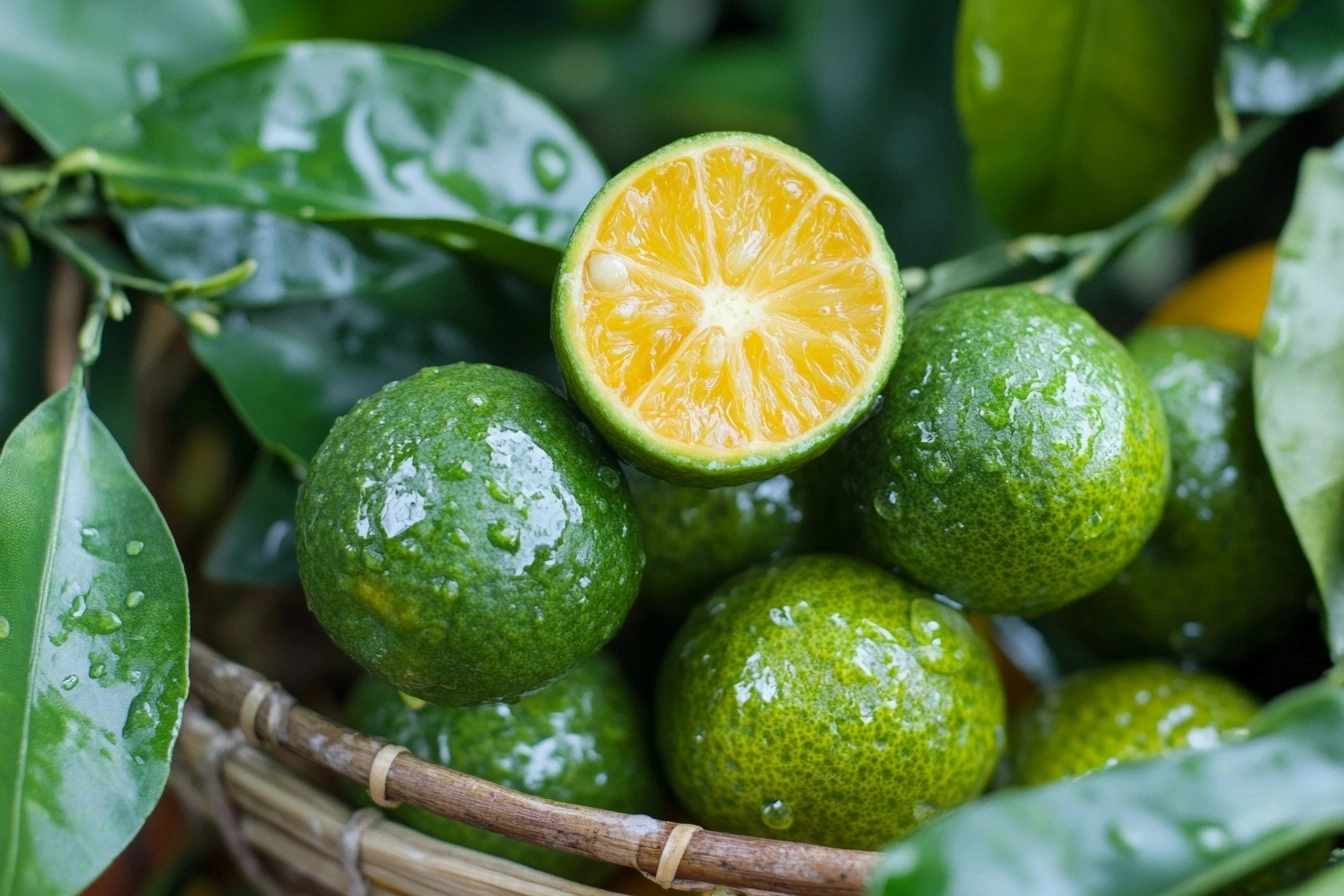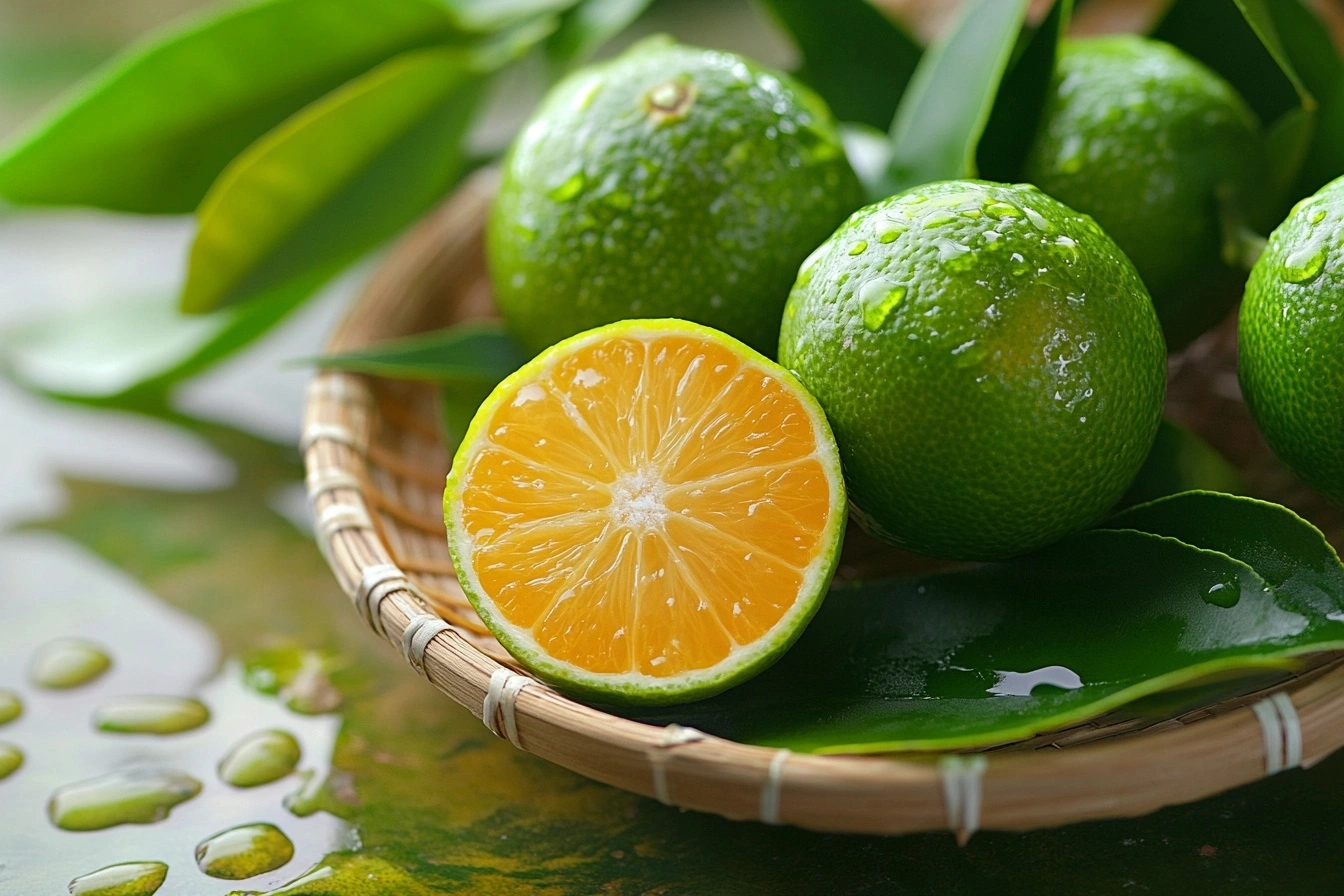Calamansi, also known as calamansi, kalamansi, or Philippine lime, is a unique citrus fruit from the Philippines. It’s known for its tangy and fragrant taste. This fruit has become popular worldwide for its many uses in cooking and its health benefits. In this guide, you’ll learn about its special features, where it comes from, and how it’s used.
Key Takeaways
- Calamansi is a unique citrus fruit native to the Philippines with a tangy and fragrant flavor.
- It has gained global recognition for its diverse culinary uses and impressive nutritional profile.
- Calamansi can be enjoyed in a variety of dishes, beverages, and cocktails, adding a zesty and refreshing touch.
- This fruit is rich in vitamin C and antioxidants, making it a healthy addition to your diet.
- Calamansi is a versatile ingredient that can be easily grown at home, allowing you to enjoy its fresh, tangy taste year-round.
What is Calamansi?
it also known as calamansi (click here to know more) or kalamansi, is a small, round citrus fruit. It has a vibrant green to yellow color when ripe. It’s a mix of kumquat and Philippine lime, giving it a unique taste that’s both tart and sweet.
the fruit is mainly grown in the Philippines. Different areas produce different types of this fruit.
An Introduction to the Tangy Citrus Delight
This fruit is a true delight for the senses. Its bright, tangy aroma and flavor make it a versatile ingredient in many Southeast Asian cuisines, especially in the Philippines. It’s used in savory dishes, refreshing beverages, or as a garnish.
Calamansi adds a vibrant, citrusy note that can make any dish better.
Origins and Varieties of Calamansi
this fruit is believed to have originated in the Philippines, where it’s been grown for centuries. It’s also known as calamandin or kalamansi, depending on the region. Each Philippine province and island has its own unique calamansi variety.

Whether you’re a seasoned calamansi enthusiast or new to this tangy citrus delight, exploring the diverse world of calamansi is truly a culinary adventure worth embarking on.
Nutritional Benefits of Calamansi
Calamansi, a small citrus fruit from the Philippines, is full of nutrients. It has a lot of vitamin C, which is great for your immune system and health.
this fruit has more vitamin C than lemons and limes. Eating one calamansi can give you up to 40% of the daily vitamin C you need.
But there’s more. its also has antioxidants. These help fight off harmful free radicals and protect your cells. This can make your immune system stronger, improve your skin, and lower the risk of diseases.
| Nutrient | Calamansi | Lemon | Lime |
|---|---|---|---|
| Vitamin C (mg per 100g) | 26 | 53 | 29 |
| Antioxidants (ORAC value) | 3,500 | 2,500 | 2,000 |
the fruit is known as a superfruit in the Philippines and worldwide. Adding it to your diet can be tasty and good for your health.

“Calamansi is a true nutritional powerhouse, offering an abundance of essential vitamins and antioxidants in a small, flavorful package.”
Calamansi: A Versatile Ingredient
This fruit, a citrus fruit from the Philippines, is a key ingredient in cooking. It’s tangy and aromatic, making it perfect for many dishes. This fruit can be used in a wide range of recipes, showing its amazing flexibility.
Culinary Uses of Calamansi
Calamansi’s flavor is great for many dishes. It’s used in marinades, dressings, baked goods, and desserts. This citrus fruit can make any dish taste better, adding a zesty touch to savory dishes and sweetness to sour or bitter ones.
Calamansi in Beverages and Cocktails
This fruit is also fantastic in drinks and cocktails. Its tangy and sweet taste adds a unique twist to juices and Philippine-inspired cocktails. Bartenders love using it to create tasty and original drinks.
“Calamansi’s versatility makes it a true culinary gem, elevating both savory and sweet dishes with its distinct citrus notes.”
it can change your cooking in many ways. It’s great for marinades, baked goods, and cocktails. Its bold flavor and flexibility make it essential for anyone wanting to explore Philippine cuisine and more.
Growing Calamansi at Home
Want to grow your own calamansi? You can do it at home, even in cooler places. this trees love well-drained soil and need regular water and sunlight. With the right care, you can harvest this tropical fruit from your garden.
Calamansi Tree Care and Maintenance
To grow this citrus fruit at home, give it the best conditions. Here are some tips:
- Choose a spot that gets lots of sunlight, at least 6 hours a day.
- Make sure the soil drains well and is full of organic matter.
- Water the tree often, but don’t let the soil get too wet.
- Fertilize it every few months with a balanced, slow-release fertilizer.
- Prune the tree to keep it shaped and encourage fruit.
- Keep the tree safe from frost and cold in winter.
With proper care, your tree will give you lots of tangy, tasty citrus fruits. You’ll get to enjoy the taste of the Philippines from your backyard.
“Growing calamansi at home is a rewarding experience, allowing you to enjoy the fresh, tangy flavor of this unique citrus fruit straight from your own garden.”
Calamansi in Filipino Cuisine
In the vibrant tapestry of Filipino cuisine, the humble citrus fruit holds a revered position. This tangy citrus delight is woven into the very fabric of traditional Philippine dishes. It lends its distinctive flavor to a myriad of savory and sweet culinary creations.
From the bustling streets of Manila to the lush, tropical islands, calamansi has become a culinary icon. It adds a zesty punch to beloved Filipino staples. Whether it’s the tangy marinade that infuses chicken adobo with depth and complexity, or the refreshing calamansi juice that quenches the thirst on a sweltering day, this versatile fruit has become an indispensable ingredient in the Filipino kitchen.
But the influence of this fruit extends beyond savory dishes. In the realm of desserts, this citrus marvel transforms traditional sweets like halo-halo and puto. It imparts a delightful balance of sweet and tart flavors. From sorbets to cakes, this citrus fruit has become a beloved ingredient that adds a touch of tropical flair to the Filipino dessert repertoire.
Whether it’s sipped as a refreshing beverage, drizzled over freshly grilled seafood, or incorporated into marinades and sauces, calamansi has become an integral part of the Filipino culinary identity. Its versatility and unique flavor profile have made it a beloved ingredient. It is cherished by home cooks and professional chefs alike, as they continue to explore the boundless possibilities of this tropical citrus delight.
“Calamansi is the heart and soul of Filipino cuisine, infusing our dishes with a tangy vibrancy that is simply unmatched.”
– Chef Margarita Fores, renownedFilipinochef and restaurateur.
Calamansi vs. Other Citrus Fruits
This citrus fruit is unique because its flavor distinctly differs from that of lemons and limes. It has a unique flavor and texture. Knowing how it compares to other citrus fruits can deepen your appreciation for it.
Comparing Flavors and Textures
it tastes tart and sweet, with a hint of bitterness. Lemons are sourer, and limes are sharper. Calamansi offers a balanced and refreshing taste.
Its skin is thin and smooth, unlike a lemon’s thick rind. Inside, calamansi is juicier and pulper than a lime. These qualities make it versatile in cooking.
| Characteristic | Calamansi | Lemon | Lime |
|---|---|---|---|
| Flavor | Tart and sweet, with a subtle bitterness | Intensely sour | Sharp and astringent |
| Acidity | Balanced | High | High |
| Skin Texture | Thin and smooth | Thick and bumpy | Thin and waxy |
| Flesh Texture | Juicy and pulpy | Dry and seedy | Dry and seedy |
Understanding calamansi’s unique traits helps you see its value in Filipino cooking. It can add flavor to many dishes and drinks.
Health Benefits of Calamansi
People also know Calamansi for its nutritional benefits. It packs Vitamin C and antioxidants, offering health advantages. It’s tangy and versatile, packed with vitamin C and antioxidants.
Calamansi’s Vitamin C and Antioxidant Properties
One calamansi fruit has up to 25% of the daily vitamin C needed. Vitamin C boosts the immune system, improves skin health, and helps absorb nutrients. Calamansi also has antioxidants that fight off harmful free radicals and protect against oxidative stress.
- Boosts Immune Function: The high vitamin C content in calamansi helps strengthen the body’s natural defenses, reducing the risk of infections and illnesses.
- Promotes Skin Health: Vitamin C and antioxidants in calamansi can help improve skin texture, reduce the appearance of fine lines and wrinkles, and even out skin tone.
- Provides Antioxidant Protection: The powerful antioxidants in calamansi can help protect cells from damage caused by free radicals, potentially reducing the risk of chronic diseases.
Adding calamansi to your diet or lifestyle is easy and tasty. Enjoy it in drinks, use it as a marinade, or apply it topically. This versatile fruit is a great addition to a healthy lifestyle.
“Calamansi is a true superfood, packed with essential nutrients and health-promoting compounds that make it a must-try for anyone looking to boost their wellness.”
Where to Find Calamansi
this fruit is a unique citrus fruit that might be hard to find in some places. But, with a little search, you can find where to get this tangy ingredient.
Specialty Asian markets are great places to look for calamansi. These markets usually have a lot of calamansi and other Asian produce.
If you can’t find an Asian market, check the produce section of some grocery stores. Availability might be low, but it’s worth asking. Stores in areas with a big Philippine or Asian population might have it.
Online shopping is also an option. You can buy calamansi from online stores that sell specialty ingredients. This is good if you can’t find it locally.
When you buy this fruit, keep it fresh by storing it right. You can refrigerate it for up to a week or freeze it for longer. With a bit of effort, you can enjoy the unique taste of it in your cooking.
Calamansi: A Taste of the Tropics
Calamansi, a vibrant citrus fruit from the Philippines, brings a burst of tropical flavor. Its bright color and tangy taste have won over food lovers around the world. Enjoy it in drinks, traditional Filipino dishes, or creative recipes to experience Southeast Asia’s unique essence.
Coming from the Philippines, calamansi is a versatile ingredient. It combines well with many flavors, adding a tangy twist to marinades, dressings, cocktails, and desserts. Its unique taste makes it a favorite in Filipino cooking, adding depth and tropical flair to dishes.
People also know Calamansi for its nutritional benefits. It packs Vitamin C and antioxidants, offering health advantages. Adding calamansi to your diet can brighten your taste and improve your well-being. It’s a true tropical delight that will excite your senses and take you to Southeast Asia.
